Project Log: Saturday,
January 30, 2010
Home Page >
The Project >
Project Logs > 1/30/10 |
I began the day by building a
fort. OK, it wasn't actually a fort: it was a
plastic enclosure to help contain the dust from yet more
days of serious grinding ahead.
Using some lumber
that I had on hand, I built a very simple frame over the
cockpit, with two vertical posts at the aft end--screwed
into the edge of the remaining poop deck--and two 8' 2x4s
running from the corners of the cabin trunk to the tops of
these vertical members. Normally I don't go around
willy-nilly inserting screws into random parts of fiberglass
boats, but it wasn't like the extra holes were going to hurt
anything here.
I draped some 16' wide plastic over
the frame and secured it with some short lengths of line as
needed to draw the plastic relatively tight. I
extended the plastic forward about half the length of the
cabin trunk. The idea wasn't to hermetically seal the
boat, but simply to limit the potential travel of the worst
of the grinding dust. |


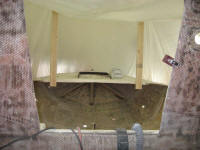 |
The task ahead: remove bad fiberglass laminate
from the fire-damaged areas inside the stern quarters of the
boat in preparation for the beginnings of repair work and
new material. My thought was to grind away enough of
the bad material from inside the boat to allow me to
laminate in several new layers of material, replacing the
thickness that I had removed. Once new,
structurally-sound material was in place inside of the boat,
I then planned to move outside and repeat the process,
essentially creating more or less a completely new laminate
in the most badly-damaged sections.
Admittedly, and
unfortunately, I'd discovered throughout the demolition
process that the damage from the fire was worse than I'd
originally anticipated. As a result, my repair plan
was necessarily fluid, and morphed continually as the
demolition progressed. During my initial interior
cleanup and grinding, I'd located several areas where the
existing laminate was badly delaminated and would clearly
have to be replaced.
Fortunately, the most severe
damage was limited to two distinct areas: the interior
sections of the port side, in the area where once was
located the port cockpit locker; and the exterior sections
of the far aft starboard side, running from the transom
forward six feet or so. Apparently, the fire's rage
and heat was concentrated to port on the inside, and the
external damage to starboard was the direct result of the
large flames that came out through the transom-mounted fuel
tank vent and wrapped around the boat from there. |
These photos, taken on January 10, show what the port (left
photo) and
starboard (right photo)looked like before
additional stock removal.
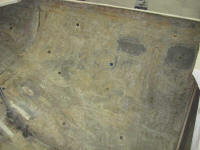
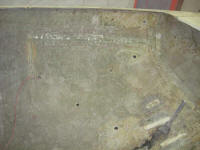 |
Before beginning, I moved the aftermost set of
jackstands a bit further forward, so they rested directly
beneath the remains of the aft bulkhead. This would
ensure that there'd be no distortion in the hull sections
when I began to remove the structural laminate from inside
the boat. Once I'd completed the initial repairs to
the stern, with new, stronger laminate in place, I'd remove
the remains of the old bulkhead, extend the repair laminate
to a point just forward of the bulkhead to ensure a strong
tie-in with the existing hull, and then replace the bulkhead
with new material. But that was down the road a piece. |
Additional photos showing the condition at the beginning of
the day's work.
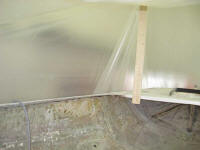
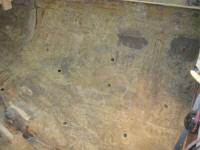 |
Armed with a new angle grinder--I'd burned up a
relatively new one during the initial demolition process--I
went to work on the inside, starting just aft of the
bulkhead on the port side. I'd considered the process
long and hard over the past weeks. Removing many
layers of fiberglass would be neither an easy nor fun chore.
For a time, I looked into alternative ways to accomplish
this.
I thought of laminate peeling, a job that I'd
have to hire out to someone with the proper equipment.
There were a number of problems with this approach from my
perspective and given the unique situation that this boat's
damage presented. The first problem was that the
existing laminate was inconsistent in thickness, with
several areas already deeply ground out from inside and
areas of the outside consumed by fire. This fact,
coupled with the additional problem that the laminate was
damaged from both sides, would have complicated the process
for a peeling contractor.
Anyway, I didn't know any
peeling contractors; frankly, peeling isn't big business
around here, and while I'm sure someone has the equipment, I
was reluctant to go the route of an outside contractor for
many of my own reasons.
Similarly, I considered a
small, hand-held peeling tool called a Gel-Plane. An
acquaintance had purchased one of these some years ago, and
since I valued his opinion I asked him about the
tool--partly to get his thoughts, and partly to see if he
still had his, and whether it might be available for
purchase or rent.
It turned out that he'd sold the
tool, but his opinion was ambivalent at best. In any
event, I wasn't about--nor able--to spend the cost of a new
Gel-Plane, about $2400, though I briefly considered it.
To this end, however, surprisingly I managed to locate one
for auction on Ebay, and I watched the auction closely and
even put in a bid for my self-imposed maximum at the end
(which at the time was much higher than the existing bid),
but unfortunately I was outbid in the last seconds of the
auction.
In any event, I determined that I'd proceed
with angle grinder and abrasive angle flap discs and see how
things went. I'd been dragging my feet a little at the
prospect--understandably, I think--but the only way to get
through this phase of the project was to just get down to
business.
I worked in sections, removing relatively
even amounts of material as I went. In several areas
on the port side, the inside laminate had already been
ground back as far as the skin coat--that is, the first
layer of mat directly beneath the gelcoat--and I didn't make
any attempts to go to this extent over the remaining areas.
My goal was to remove enough material on the inside (and in
as even a manner as possible) to allow me to install new
material without vastly increasing the net weight of the
boat, and also to remove enough so that I could continue the
process from outside the boat later, hopefully removing
enough material from the exterior to meet up with the new
laminate on the inside. Fortunately, the inside of the
hull didn't need to be fair in the way that the exterior
would need to be. I had a plan in mind for helping me
to guide the depth of cut when I got to the outside, but
more on that when the time comes.
There was little to
tell: I ground, and ground, and ground, and created
huge piles of talc-consistency dust. Good times.
I thinned out the laminate over most of the exposed area of
the port side, from about 10" aft of the bulkhead (the one
beneath the aft end of the cabin trunk) to the area just
beneath the poop deck, where there had once been another
bulkhead. Clearly, these bulkheads had worked quite
well as fire stops, as the quality of the remaining laminate
increased dramatically aft of this bulkhead (and forward of
the other bulkhead). |
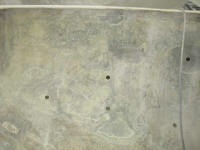
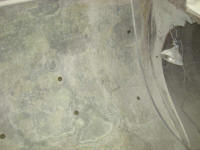
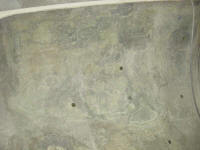 |
Similarly, I repeated the process on the starboard
side, though here the damage was much more concentrated
(fortunately), and was located mostly in the aftermost
sections of the boat and up closer to the hull-deck joint a
bit further forward. But although the damaged area was
smaller in area on the starboard side, the actual laminate
damage (where it existed) was far worse than on the port,
with large areas completely delaminated and unsalvageable; I
couldn't even grind away all the bad material, lest I simply
grind away the entire hull. I removed as much as I
could from inside, up to 7 layers of roving my my count, and
would get the rest when I moved to the exterior of the hull
later, though there was one area where I sanded clean
through. Clearly, the heat must have been intense in
this area during the fire. |
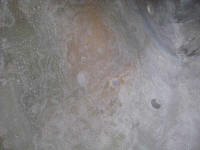
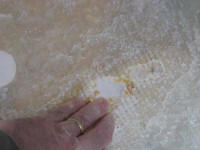
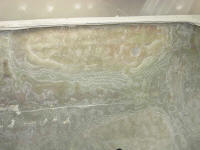 |
I swept up the worst of the day's debris,
half-filling the bilge, and called it a day. I'd
complete the cleanup tomorrow: there was simply so
much dust in the air inside my fort that it accumulated on
the hull almost as fast as I could sweep it up, so I thought
it'd be better to let things settle. |
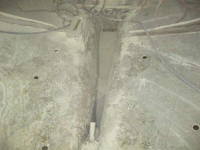 |
Total Time Today: 4.25 hours |
Previous |
Next |
|
|